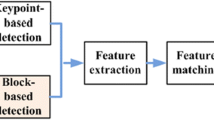Abstract
This paper presents a novel method for image manipulation iden- tification of natural images in JPEG format. The image forgery detection technique is based on a signal-dependent noise model that is relevant to de- scribe a natural image acquired by a digital camera. This parametric model is characterized by two fingerprints which are used to falsification identification. The problem is cast in the framework of the hypothesis testing theory. For practical use, the Generalized Likelihood Ratio Tests (GLRT) are presented and their performance is theoretically established. There are different types of image forgery which have been considered in this paper for example re- sampling, Gaussian filtering and median filtering. Experiments with real and simulated images highlight the relevance of the proposed approach.








Similar content being viewed by others
References
Bayar B, Stamm MC (2017) On the robustness of constrained convolutional neural networks to jpeg post-compression for image resampling detection. In: acoustics, speech and signal processing (ICASSP), 2017 IEEE international conference on, pp 2152–2156
Doan TNC, Retraint F, Zitzmann C (2017) Blind forensics tool of falsification for im- ages. In: 2017 IEEE international symposium on signal processing and information technology (ISSPIT), pp 018–023
Gloe T, Bohme R (2010) The Dresden image database for benchmarking digital image forensics. Journal of Digital Forensic Practice 3(2–4):150–159
Hwang JJ, Rhee KH (2016) Gaussian filtering detection based on features of residuals in image forensics. In: Computing & Communication Technologies, Research, Innovation, and Vision for the Future (RIVF), 2016 IEEE RIVF International Conference on, pp153–157
Jin J, Jing P, Su Y (2019) AMFNet: an adversarial network for median filtering detection. IEEE Access 6:50459–50467
Julliand T, Nozick V, Talbot H (2016) Automatic image splicing detection based on noise density analysis in raw images. In: International Conference on Advanced Concepts for Intelligent Vision Systems, Springer, pp. 126–134
Le N, Retraint F (2018) Statistical detector of resampled tiff images. In: 2018 IEEE international symposium on signal processing and information technology (ISSPIT), pp 331–335
Le N, Retraint F (2019) An improved algorithm for digital image authentication and forgery localization using Demosaicing artifacts. IEEE Access 7:125038–125053
Liu XL, Lin CC, Yuan SM (2018) Blind dual watermarking for color images au- thentication and copyright protection. IEEE Transactions on Circuits and Systems for Video Technology 28(5):1047–1055
Liu Y, Zhu X, Zhao X, Cao Y (2019) Adversarial learning for constrained image splicing detection and localization based on atrous convolution. IEEE Transactions on Informa- tion Forensics and Security 14(10):2551–2566
Luo S, Peng A, Zeng H, Kang X, Liu L (2019) Deep residual learning using data aug- mentation for median filtering forensics of digital images. IEEE Access 7:80614–80621
Nelder JA, Mead R (1965) A simplex method for function minimization. Comput J 7(4):308–313
Nguyen HP, Retraint F, Morain-Nicolier F, Delahaies A (2019) An image forgery De- tection solution based on DCT coefficient analysis. International Conference on Information Systems Security and Privacy 2019:487–494
Niu Y, Zhao Y, Ni R (2017) Robust median filtering detection based on local difference descriptor. Signal Process Image Commun 53:65–72
Qiao T, Retraint F (2018) Identifying individual camera device from RAW images. IEEE Access 6:78038–78054
Qiao T, Retraint F, Cogranne R, Thai TH (2017) Individual camera device identification from JPEG images. Sig. Proc.: image Comm. 52: 74–86
Qiao T, Zhu A, Retraint F (2018) Exposing image resampling forgery by using linear parametric model. Multimedia Tools Appl 77(2):1501–1523
Redi JA, Taktak W, Dugelay JL (2011) Digital image forensics: a booklet for beginners. Multimed Tools Appl 51(1):133–162
Rhee KH (2016) Gaussian filtering detection using band pass residual and contrast of forgery image. In: information technology, electronics and Mobile communication conference (IEMCON), 2016 IEEE 7th annual, pp 1–4
Rhee KH (2017) Median filtering detection based on variations and residuals in image forensics. Turkish Journal of Electrical Engineering & Computer Sciences 25(5):3811–3826
Rhee KH (2019) Forensic detection using bit-planes slicing of median filtering image. IEEE Access 7:92586–92597
Romano JP, Lehmann E (2005) Testing statistical hypotheses
Rousseeuw PJ, Croux C (1993) Alternatives to the median absolute deviation. J Am Stat Assoc 88(424):1273–1283
Scott C (2007) Performance measures for neyman–Pearson classification. IEEE Trans- actions on Information Theory 53(8):2852–2863
Sheng H, Shen X, Lyu Y, Shi Z, Ma S (2018) Image splicing detection based on Markov features in discrete octonion cosine transform domain. IET Image Process 12(10):1815–1823
Su Y, Jin X, Zhang C, Chen Y (2017) Hierarchical image resampling detection based on blind deconvolution. J Vis Commun Image Represent 48:480–490
Thai TH, Retraint F, Cogranne R (2012) Statistical model of natural images. In: image processing (ICIP), 2012 19th IEEE international conference on, pp 2525–2528
Thai TH, Cogranne R, Retraint F (2014) Camera model identification based on the heteroscedastic noise model. IEEE Trans Image Process 23(1):250–263
Thai TH, Retraint F, Cogranne R (2015) Generalized signal-dependent noise model and parameter estimation for natural images. Signal Process 114:164–170
Thai TH, Retraint F, Cogranne R (2016) Camera model identification based on the generalized noise model in natural images. Digital Signal Processing 48:285–297
Yu L, Zhang Y, Han H, Zhang L, Wu F (2019) Robust median filtering forensics by CNN-based multiple residuals learning. IEEE Access 7:120594–120602
Acknowledgements
This work was supported by ANR project DEFACTO ANR-16-DEFA-0002.
Author information
Authors and Affiliations
Corresponding author
Additional information
Publisher’s note
Springer Nature remains neutral with regard to jurisdictional claims in published maps and institutional affiliations.
A Proof of Proposition 1
A Proof of Proposition 1
Based on the Delta method [18, theorem 11.2.14], we derive
and
Consequently, based on the law of the total variance, it follows that
Rights and permissions
About this article
Cite this article
Doan, T.N.C., Retraint, . & Zitzmann, C. Image tampering detection based on a statistical model. Multimed Tools Appl 80, 32905–32924 (2021). https://doi.org/10.1007/s11042-021-11213-3
Received:
Revised:
Accepted:
Published:
Issue Date:
DOI: https://doi.org/10.1007/s11042-021-11213-3




